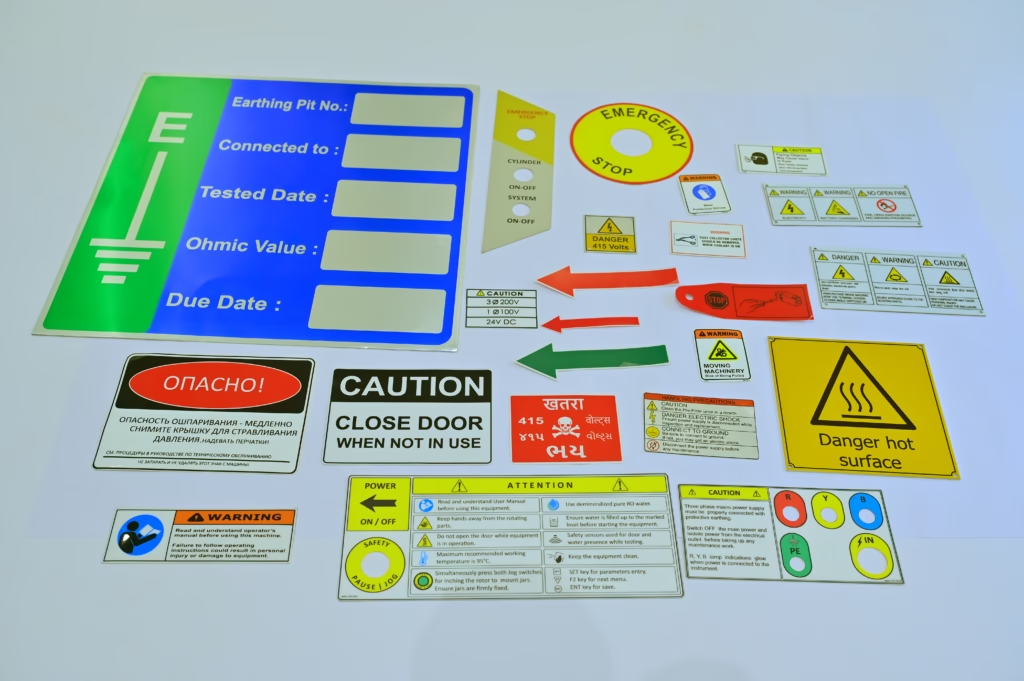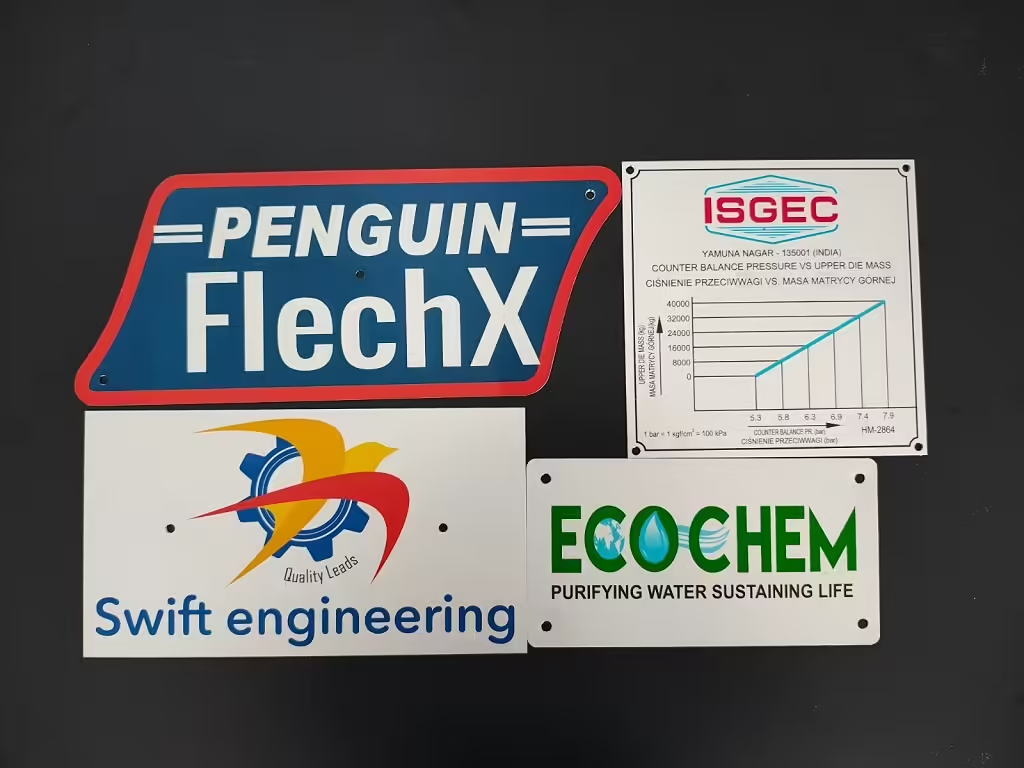The terms “labels” and “nameplates” are often used interchangeably, but there are some key distinctions:
Labels:
- Material: Can be made from a wider variety of materials, including paper, vinyl, cloth, or even metal foil, but generally less durable than nameplates.
- Purpose: Have a broader range of applications, including product identification, instructions, warnings, barcodes, and decorative elements.
- Durability: Can vary greatly depending on the material and intended use. Some labels are designed for short-term use, while others are more durable and can withstand moderate environmental conditions.
- Appearance: Can range from simple printed labels to more complex designs with graphics and images.
- Attachment: Usually attached using adhesives, but can also be sewn, stapled, or tied.
Nameplates:
- Material: Typically made of more durable materials like metal (aluminum, stainless steel), plastic (polycarbonate, acrylic), or ceramic.
- Purpose: Primarily used for permanent identification and branding of products, equipment, or facilities. They often convey essential information like product name, model number, serial number, manufacturer, and safety instructions.
- Durability: Designed to withstand harsh environments, abrasion, chemicals, and extreme temperatures.
- Appearance: Often more substantial and professional-looking, with raised lettering, engraving, or other decorative elements.
- Attachment: Typically attached using screws, rivets, or strong adhesives.
- Nameplates are typically more durable, permanent, and professional-looking, designed to provide long-lasting identification and branding.
- Labels are more versatile and can be used for a wider range of purposes, but may not be as durable or long-lasting as nameplates.
Equipment nameplates are mandatory for identifying and tracing industrial machines, equipment and vehicles. Typically made of metal or plastic to withstand the test of time, these identification plates come in various sizes and shapes, and provide essential information about a product or machine. They can include a logo, brand, address, serial numbers, text, safety instructions, pictograms, or symbols. These plates must comply with various regulations depending on the geographic region in which they are sold.
Equipment nameplates can be made from various materials, to resist all kinds of conditions:
Nameplates come in a huge variety of styles and materials. The best nameplate material for your needs will depend upon a few different factors including your industry, the purpose of the nameplate, and the environment it will be used in.
This brief guide will help you decide on the best choice for your needs but let’s start from the beginning by asking what is a nameplate?
What Is A NamePlate?
A nameplate is a type of signage. Usually, as the name suggests, a nameplate has the name of a person, home or business but a nameplate is also sometimes used as a term for more general signage too.
Nameplates are found in many places from machinary,office doors, desks and indoor walls to outside placements such as parking spaces, external walls and doors.
NamePlate Materials
Acrylic Name Plates
Durable, weatherproof, easy to clean and ideal for a modern look. Acrylic nameplates are also versatile, as they can be cut into any number of shapes and come in various thicknesses.
LED Name Plate
Adding lights either behind an acrylic nameplate, so the light shines through it, or having an LED light shining onto the nameplate from below, above or from the side of the nameplate is a useful addition to a nameplate that you want people to be able to see clearly at any time of day. These are not only useful for restaurants but also for homes that are notoriously difficult to find in the dark.
Stainless Steel Name Plates
For maximum durability, stainless steel is hard to beat. Weatherproof and easy to clean, it also takes a variety of methods of marking well such as engraving, stamping, and embossing.
Aluminium Name Plate
Lightweight, easy to work with, versatile and durable aluminium is an excellent choice as a nameplate material.
Brass Name Plate
For a touch of luxury and best used in an indoor setting, brass is a great executive look.
Which Is The Best Name Plate Material?
As you can see from this guide, there are a variety of materials used for name plates and your choice will depend on the style you are looking for as well as your budget.
However, for an all-round affordable, durable and versatile look that suits business and home equally well, aluminium and stainless steel are hard to beat.
How To Get A Name Plate Made
You want your nameplate to last and be of excellent quality. At Furnells, we have been making nameplates for over 30 years. Why not get in touch with us, and you can join our long list of happy customers?



# 139, KIADB Indl Area, 4th Phase, Bommasandra, Hosur-Jigani Link Road Bangalore, India 560099
Machine & Equipment’s
Pharma/On-site Signage
For Enquires:
- enquiry@kinelectro.com
- +919686466322 +919980454999
